Nursing Case Study Assessment on Severe Sepsis with Pneumococcal Presentation
VerifiedAdded on 2023/06/14
|7
|2449
|279
AI Summary
This nursing case study assessment analyzes a patient with severe sepsis and pneumococcal presentation. It covers pathogenesis, medication protocols, nursing priorities, and arterial blood gas analysis.
Contribute Materials
Your contribution can guide someone’s learning journey. Share your
documents today.
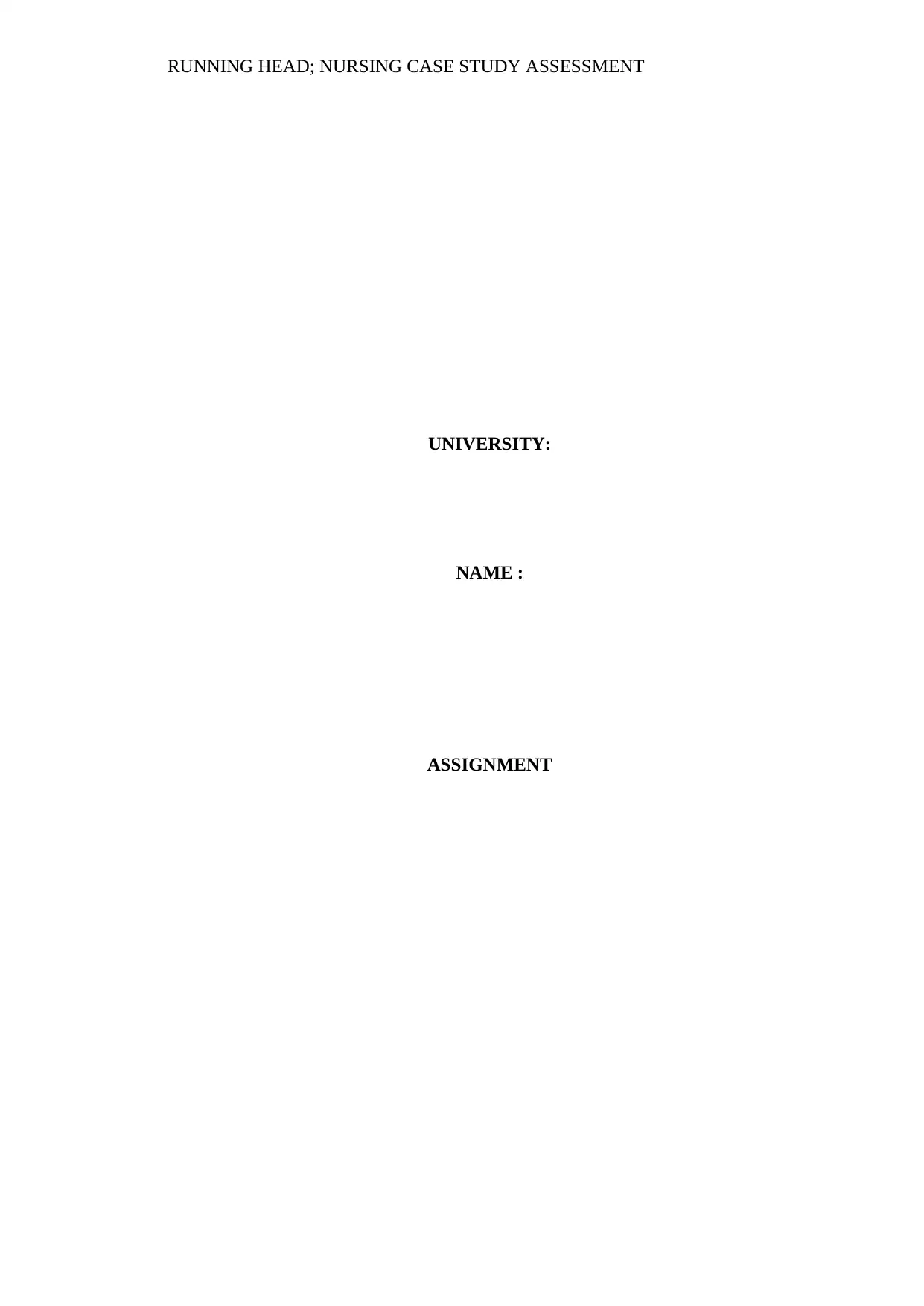
RUNNING HEAD; NURSING CASE STUDY ASSESSMENT
UNIVERSITY:
NAME :
ASSIGNMENT
UNIVERSITY:
NAME :
ASSIGNMENT
Secure Best Marks with AI Grader
Need help grading? Try our AI Grader for instant feedback on your assignments.
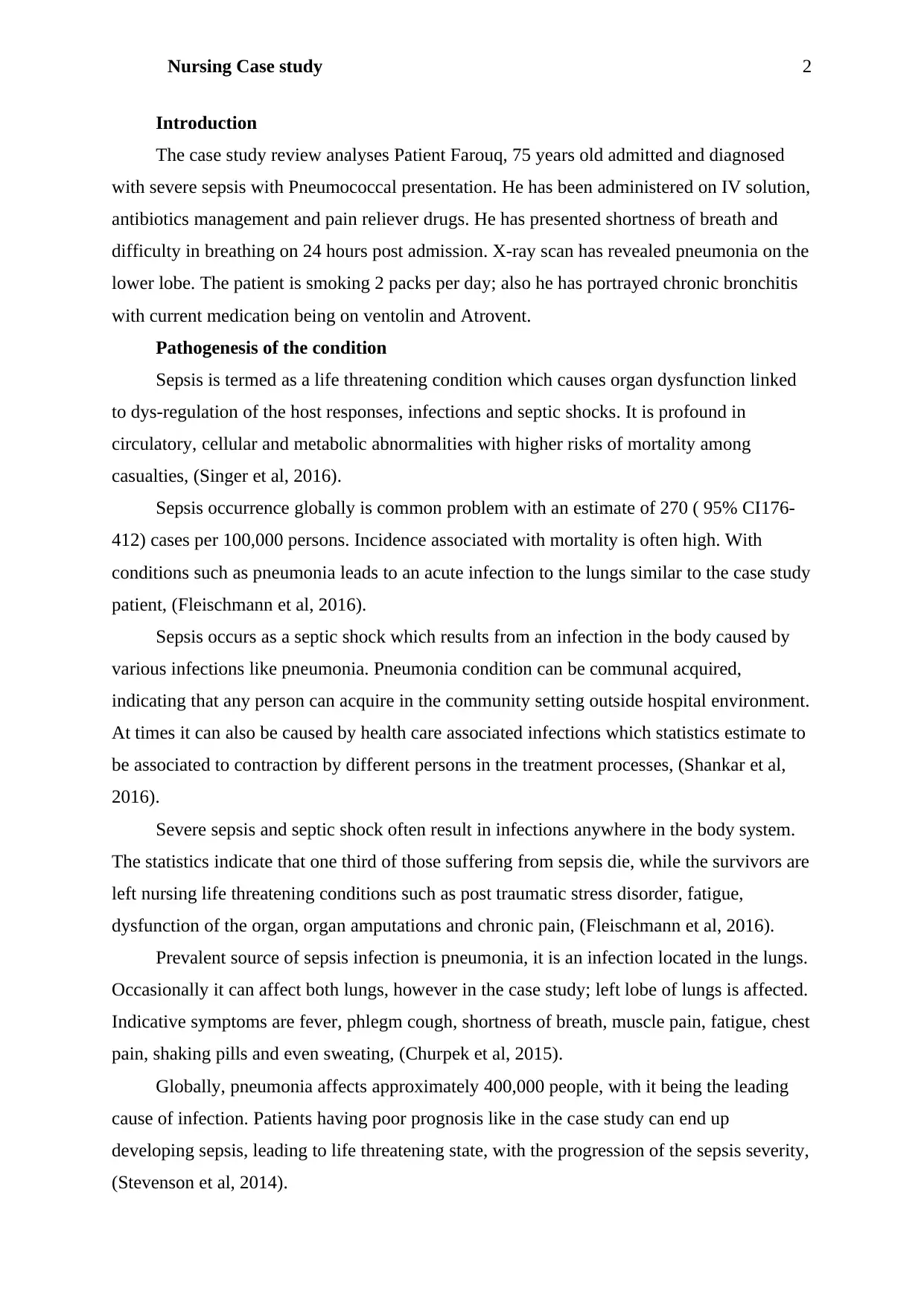
Nursing Case study 2
Introduction
The case study review analyses Patient Farouq, 75 years old admitted and diagnosed
with severe sepsis with Pneumococcal presentation. He has been administered on IV solution,
antibiotics management and pain reliever drugs. He has presented shortness of breath and
difficulty in breathing on 24 hours post admission. X-ray scan has revealed pneumonia on the
lower lobe. The patient is smoking 2 packs per day; also he has portrayed chronic bronchitis
with current medication being on ventolin and Atrovent.
Pathogenesis of the condition
Sepsis is termed as a life threatening condition which causes organ dysfunction linked
to dys-regulation of the host responses, infections and septic shocks. It is profound in
circulatory, cellular and metabolic abnormalities with higher risks of mortality among
casualties, (Singer et al, 2016).
Sepsis occurrence globally is common problem with an estimate of 270 ( 95% CI176-
412) cases per 100,000 persons. Incidence associated with mortality is often high. With
conditions such as pneumonia leads to an acute infection to the lungs similar to the case study
patient, (Fleischmann et al, 2016).
Sepsis occurs as a septic shock which results from an infection in the body caused by
various infections like pneumonia. Pneumonia condition can be communal acquired,
indicating that any person can acquire in the community setting outside hospital environment.
At times it can also be caused by health care associated infections which statistics estimate to
be associated to contraction by different persons in the treatment processes, (Shankar et al,
2016).
Severe sepsis and septic shock often result in infections anywhere in the body system.
The statistics indicate that one third of those suffering from sepsis die, while the survivors are
left nursing life threatening conditions such as post traumatic stress disorder, fatigue,
dysfunction of the organ, organ amputations and chronic pain, (Fleischmann et al, 2016).
Prevalent source of sepsis infection is pneumonia, it is an infection located in the lungs.
Occasionally it can affect both lungs, however in the case study; left lobe of lungs is affected.
Indicative symptoms are fever, phlegm cough, shortness of breath, muscle pain, fatigue, chest
pain, shaking pills and even sweating, (Churpek et al, 2015).
Globally, pneumonia affects approximately 400,000 people, with it being the leading
cause of infection. Patients having poor prognosis like in the case study can end up
developing sepsis, leading to life threatening state, with the progression of the sepsis severity,
(Stevenson et al, 2014).
Introduction
The case study review analyses Patient Farouq, 75 years old admitted and diagnosed
with severe sepsis with Pneumococcal presentation. He has been administered on IV solution,
antibiotics management and pain reliever drugs. He has presented shortness of breath and
difficulty in breathing on 24 hours post admission. X-ray scan has revealed pneumonia on the
lower lobe. The patient is smoking 2 packs per day; also he has portrayed chronic bronchitis
with current medication being on ventolin and Atrovent.
Pathogenesis of the condition
Sepsis is termed as a life threatening condition which causes organ dysfunction linked
to dys-regulation of the host responses, infections and septic shocks. It is profound in
circulatory, cellular and metabolic abnormalities with higher risks of mortality among
casualties, (Singer et al, 2016).
Sepsis occurrence globally is common problem with an estimate of 270 ( 95% CI176-
412) cases per 100,000 persons. Incidence associated with mortality is often high. With
conditions such as pneumonia leads to an acute infection to the lungs similar to the case study
patient, (Fleischmann et al, 2016).
Sepsis occurs as a septic shock which results from an infection in the body caused by
various infections like pneumonia. Pneumonia condition can be communal acquired,
indicating that any person can acquire in the community setting outside hospital environment.
At times it can also be caused by health care associated infections which statistics estimate to
be associated to contraction by different persons in the treatment processes, (Shankar et al,
2016).
Severe sepsis and septic shock often result in infections anywhere in the body system.
The statistics indicate that one third of those suffering from sepsis die, while the survivors are
left nursing life threatening conditions such as post traumatic stress disorder, fatigue,
dysfunction of the organ, organ amputations and chronic pain, (Fleischmann et al, 2016).
Prevalent source of sepsis infection is pneumonia, it is an infection located in the lungs.
Occasionally it can affect both lungs, however in the case study; left lobe of lungs is affected.
Indicative symptoms are fever, phlegm cough, shortness of breath, muscle pain, fatigue, chest
pain, shaking pills and even sweating, (Churpek et al, 2015).
Globally, pneumonia affects approximately 400,000 people, with it being the leading
cause of infection. Patients having poor prognosis like in the case study can end up
developing sepsis, leading to life threatening state, with the progression of the sepsis severity,
(Stevenson et al, 2014).
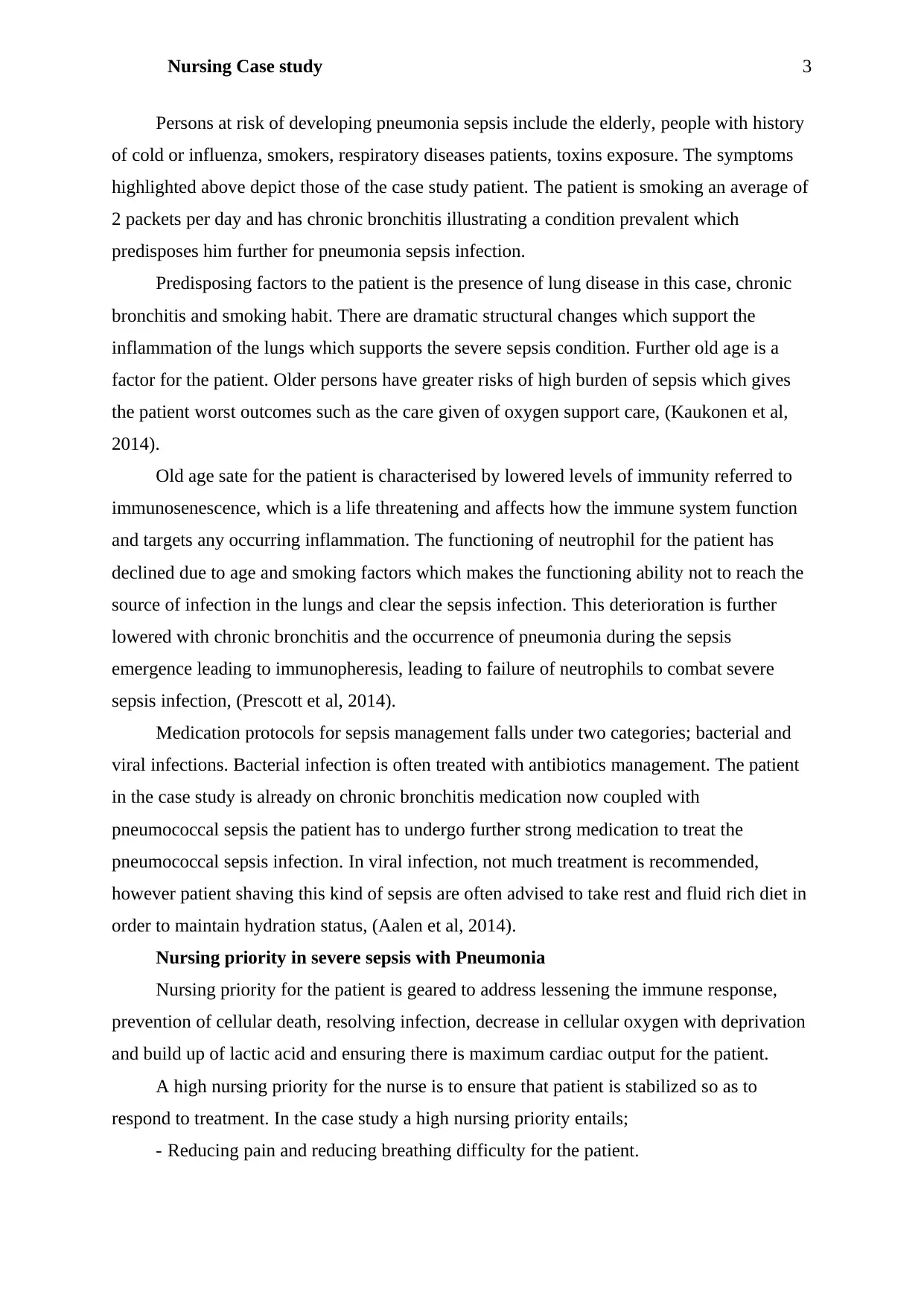
Nursing Case study 3
Persons at risk of developing pneumonia sepsis include the elderly, people with history
of cold or influenza, smokers, respiratory diseases patients, toxins exposure. The symptoms
highlighted above depict those of the case study patient. The patient is smoking an average of
2 packets per day and has chronic bronchitis illustrating a condition prevalent which
predisposes him further for pneumonia sepsis infection.
Predisposing factors to the patient is the presence of lung disease in this case, chronic
bronchitis and smoking habit. There are dramatic structural changes which support the
inflammation of the lungs which supports the severe sepsis condition. Further old age is a
factor for the patient. Older persons have greater risks of high burden of sepsis which gives
the patient worst outcomes such as the care given of oxygen support care, (Kaukonen et al,
2014).
Old age sate for the patient is characterised by lowered levels of immunity referred to
immunosenescence, which is a life threatening and affects how the immune system function
and targets any occurring inflammation. The functioning of neutrophil for the patient has
declined due to age and smoking factors which makes the functioning ability not to reach the
source of infection in the lungs and clear the sepsis infection. This deterioration is further
lowered with chronic bronchitis and the occurrence of pneumonia during the sepsis
emergence leading to immunopheresis, leading to failure of neutrophils to combat severe
sepsis infection, (Prescott et al, 2014).
Medication protocols for sepsis management falls under two categories; bacterial and
viral infections. Bacterial infection is often treated with antibiotics management. The patient
in the case study is already on chronic bronchitis medication now coupled with
pneumococcal sepsis the patient has to undergo further strong medication to treat the
pneumococcal sepsis infection. In viral infection, not much treatment is recommended,
however patient shaving this kind of sepsis are often advised to take rest and fluid rich diet in
order to maintain hydration status, (Aalen et al, 2014).
Nursing priority in severe sepsis with Pneumonia
Nursing priority for the patient is geared to address lessening the immune response,
prevention of cellular death, resolving infection, decrease in cellular oxygen with deprivation
and build up of lactic acid and ensuring there is maximum cardiac output for the patient.
A high nursing priority for the nurse is to ensure that patient is stabilized so as to
respond to treatment. In the case study a high nursing priority entails;
- Reducing pain and reducing breathing difficulty for the patient.
Persons at risk of developing pneumonia sepsis include the elderly, people with history
of cold or influenza, smokers, respiratory diseases patients, toxins exposure. The symptoms
highlighted above depict those of the case study patient. The patient is smoking an average of
2 packets per day and has chronic bronchitis illustrating a condition prevalent which
predisposes him further for pneumonia sepsis infection.
Predisposing factors to the patient is the presence of lung disease in this case, chronic
bronchitis and smoking habit. There are dramatic structural changes which support the
inflammation of the lungs which supports the severe sepsis condition. Further old age is a
factor for the patient. Older persons have greater risks of high burden of sepsis which gives
the patient worst outcomes such as the care given of oxygen support care, (Kaukonen et al,
2014).
Old age sate for the patient is characterised by lowered levels of immunity referred to
immunosenescence, which is a life threatening and affects how the immune system function
and targets any occurring inflammation. The functioning of neutrophil for the patient has
declined due to age and smoking factors which makes the functioning ability not to reach the
source of infection in the lungs and clear the sepsis infection. This deterioration is further
lowered with chronic bronchitis and the occurrence of pneumonia during the sepsis
emergence leading to immunopheresis, leading to failure of neutrophils to combat severe
sepsis infection, (Prescott et al, 2014).
Medication protocols for sepsis management falls under two categories; bacterial and
viral infections. Bacterial infection is often treated with antibiotics management. The patient
in the case study is already on chronic bronchitis medication now coupled with
pneumococcal sepsis the patient has to undergo further strong medication to treat the
pneumococcal sepsis infection. In viral infection, not much treatment is recommended,
however patient shaving this kind of sepsis are often advised to take rest and fluid rich diet in
order to maintain hydration status, (Aalen et al, 2014).
Nursing priority in severe sepsis with Pneumonia
Nursing priority for the patient is geared to address lessening the immune response,
prevention of cellular death, resolving infection, decrease in cellular oxygen with deprivation
and build up of lactic acid and ensuring there is maximum cardiac output for the patient.
A high nursing priority for the nurse is to ensure that patient is stabilized so as to
respond to treatment. In the case study a high nursing priority entails;
- Reducing pain and reducing breathing difficulty for the patient.
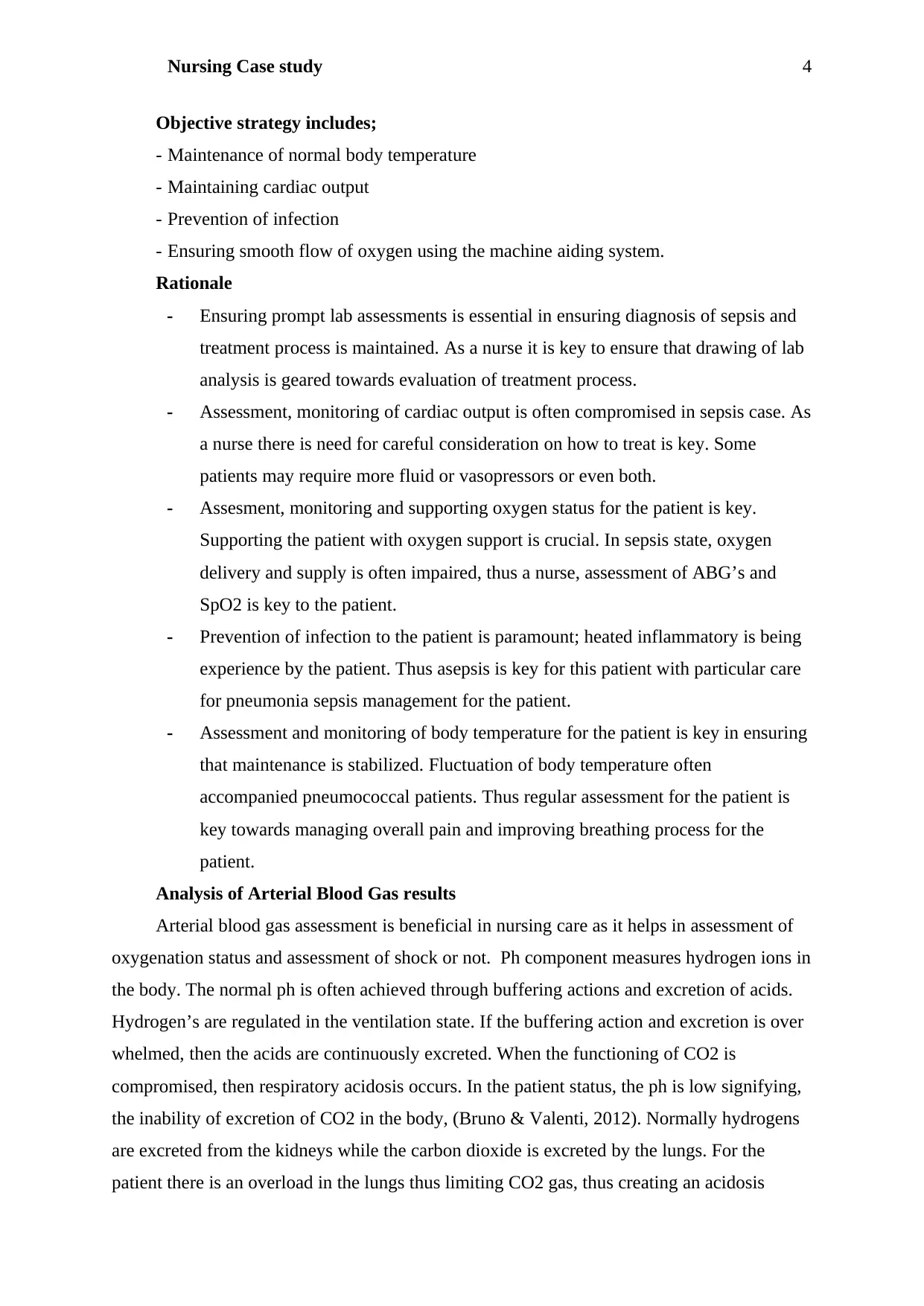
Nursing Case study 4
Objective strategy includes;
- Maintenance of normal body temperature
- Maintaining cardiac output
- Prevention of infection
- Ensuring smooth flow of oxygen using the machine aiding system.
Rationale
- Ensuring prompt lab assessments is essential in ensuring diagnosis of sepsis and
treatment process is maintained. As a nurse it is key to ensure that drawing of lab
analysis is geared towards evaluation of treatment process.
- Assessment, monitoring of cardiac output is often compromised in sepsis case. As
a nurse there is need for careful consideration on how to treat is key. Some
patients may require more fluid or vasopressors or even both.
- Assesment, monitoring and supporting oxygen status for the patient is key.
Supporting the patient with oxygen support is crucial. In sepsis state, oxygen
delivery and supply is often impaired, thus a nurse, assessment of ABG’s and
SpO2 is key to the patient.
- Prevention of infection to the patient is paramount; heated inflammatory is being
experience by the patient. Thus asepsis is key for this patient with particular care
for pneumonia sepsis management for the patient.
- Assessment and monitoring of body temperature for the patient is key in ensuring
that maintenance is stabilized. Fluctuation of body temperature often
accompanied pneumococcal patients. Thus regular assessment for the patient is
key towards managing overall pain and improving breathing process for the
patient.
Analysis of Arterial Blood Gas results
Arterial blood gas assessment is beneficial in nursing care as it helps in assessment of
oxygenation status and assessment of shock or not. Ph component measures hydrogen ions in
the body. The normal ph is often achieved through buffering actions and excretion of acids.
Hydrogen’s are regulated in the ventilation state. If the buffering action and excretion is over
whelmed, then the acids are continuously excreted. When the functioning of CO2 is
compromised, then respiratory acidosis occurs. In the patient status, the ph is low signifying,
the inability of excretion of CO2 in the body, (Bruno & Valenti, 2012). Normally hydrogens
are excreted from the kidneys while the carbon dioxide is excreted by the lungs. For the
patient there is an overload in the lungs thus limiting CO2 gas, thus creating an acidosis
Objective strategy includes;
- Maintenance of normal body temperature
- Maintaining cardiac output
- Prevention of infection
- Ensuring smooth flow of oxygen using the machine aiding system.
Rationale
- Ensuring prompt lab assessments is essential in ensuring diagnosis of sepsis and
treatment process is maintained. As a nurse it is key to ensure that drawing of lab
analysis is geared towards evaluation of treatment process.
- Assessment, monitoring of cardiac output is often compromised in sepsis case. As
a nurse there is need for careful consideration on how to treat is key. Some
patients may require more fluid or vasopressors or even both.
- Assesment, monitoring and supporting oxygen status for the patient is key.
Supporting the patient with oxygen support is crucial. In sepsis state, oxygen
delivery and supply is often impaired, thus a nurse, assessment of ABG’s and
SpO2 is key to the patient.
- Prevention of infection to the patient is paramount; heated inflammatory is being
experience by the patient. Thus asepsis is key for this patient with particular care
for pneumonia sepsis management for the patient.
- Assessment and monitoring of body temperature for the patient is key in ensuring
that maintenance is stabilized. Fluctuation of body temperature often
accompanied pneumococcal patients. Thus regular assessment for the patient is
key towards managing overall pain and improving breathing process for the
patient.
Analysis of Arterial Blood Gas results
Arterial blood gas assessment is beneficial in nursing care as it helps in assessment of
oxygenation status and assessment of shock or not. Ph component measures hydrogen ions in
the body. The normal ph is often achieved through buffering actions and excretion of acids.
Hydrogen’s are regulated in the ventilation state. If the buffering action and excretion is over
whelmed, then the acids are continuously excreted. When the functioning of CO2 is
compromised, then respiratory acidosis occurs. In the patient status, the ph is low signifying,
the inability of excretion of CO2 in the body, (Bruno & Valenti, 2012). Normally hydrogens
are excreted from the kidneys while the carbon dioxide is excreted by the lungs. For the
patient there is an overload in the lungs thus limiting CO2 gas, thus creating an acidosis
Secure Best Marks with AI Grader
Need help grading? Try our AI Grader for instant feedback on your assignments.
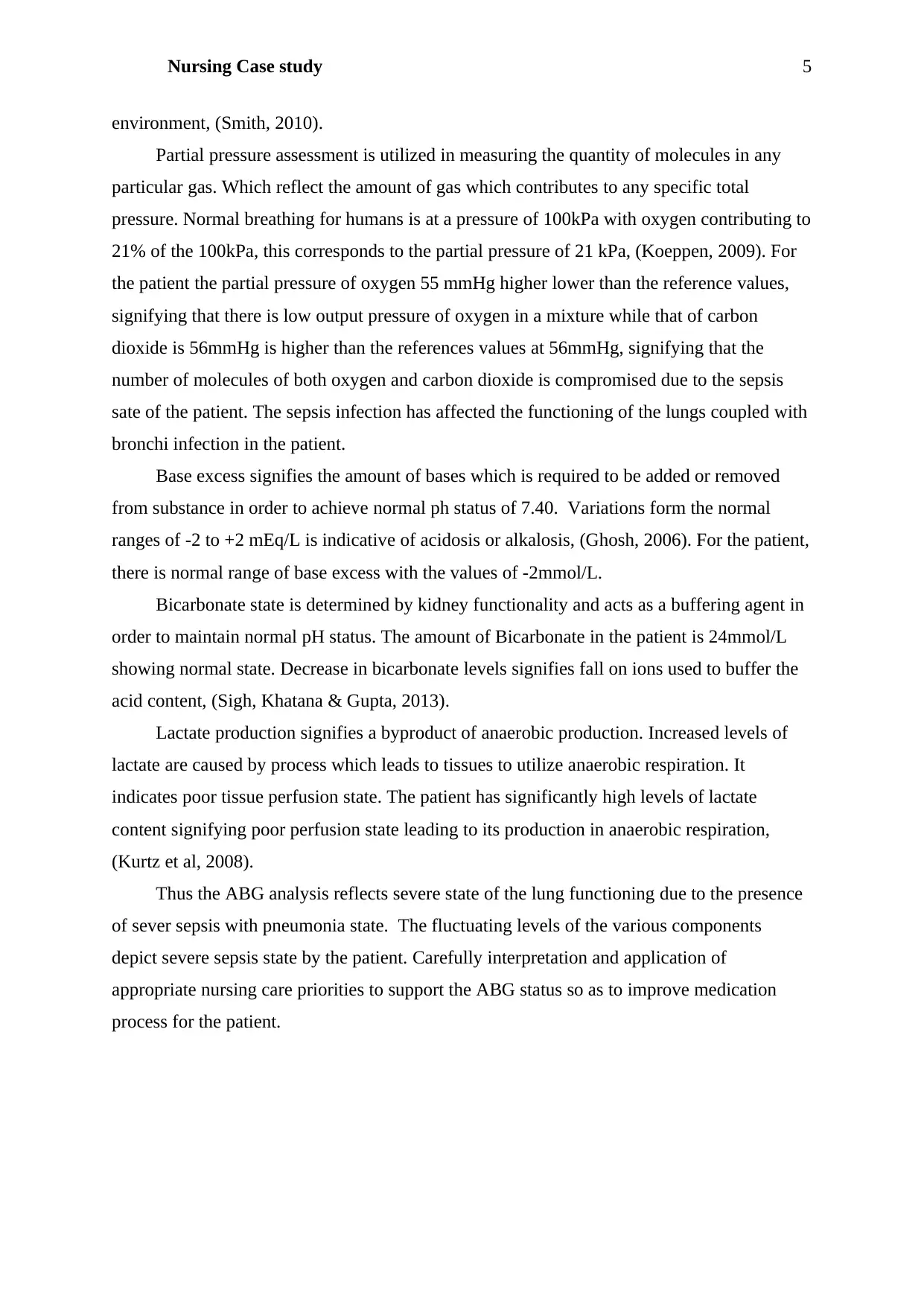
Nursing Case study 5
environment, (Smith, 2010).
Partial pressure assessment is utilized in measuring the quantity of molecules in any
particular gas. Which reflect the amount of gas which contributes to any specific total
pressure. Normal breathing for humans is at a pressure of 100kPa with oxygen contributing to
21% of the 100kPa, this corresponds to the partial pressure of 21 kPa, (Koeppen, 2009). For
the patient the partial pressure of oxygen 55 mmHg higher lower than the reference values,
signifying that there is low output pressure of oxygen in a mixture while that of carbon
dioxide is 56mmHg is higher than the references values at 56mmHg, signifying that the
number of molecules of both oxygen and carbon dioxide is compromised due to the sepsis
sate of the patient. The sepsis infection has affected the functioning of the lungs coupled with
bronchi infection in the patient.
Base excess signifies the amount of bases which is required to be added or removed
from substance in order to achieve normal ph status of 7.40. Variations form the normal
ranges of -2 to +2 mEq/L is indicative of acidosis or alkalosis, (Ghosh, 2006). For the patient,
there is normal range of base excess with the values of -2mmol/L.
Bicarbonate state is determined by kidney functionality and acts as a buffering agent in
order to maintain normal pH status. The amount of Bicarbonate in the patient is 24mmol/L
showing normal state. Decrease in bicarbonate levels signifies fall on ions used to buffer the
acid content, (Sigh, Khatana & Gupta, 2013).
Lactate production signifies a byproduct of anaerobic production. Increased levels of
lactate are caused by process which leads to tissues to utilize anaerobic respiration. It
indicates poor tissue perfusion state. The patient has significantly high levels of lactate
content signifying poor perfusion state leading to its production in anaerobic respiration,
(Kurtz et al, 2008).
Thus the ABG analysis reflects severe state of the lung functioning due to the presence
of sever sepsis with pneumonia state. The fluctuating levels of the various components
depict severe sepsis state by the patient. Carefully interpretation and application of
appropriate nursing care priorities to support the ABG status so as to improve medication
process for the patient.
environment, (Smith, 2010).
Partial pressure assessment is utilized in measuring the quantity of molecules in any
particular gas. Which reflect the amount of gas which contributes to any specific total
pressure. Normal breathing for humans is at a pressure of 100kPa with oxygen contributing to
21% of the 100kPa, this corresponds to the partial pressure of 21 kPa, (Koeppen, 2009). For
the patient the partial pressure of oxygen 55 mmHg higher lower than the reference values,
signifying that there is low output pressure of oxygen in a mixture while that of carbon
dioxide is 56mmHg is higher than the references values at 56mmHg, signifying that the
number of molecules of both oxygen and carbon dioxide is compromised due to the sepsis
sate of the patient. The sepsis infection has affected the functioning of the lungs coupled with
bronchi infection in the patient.
Base excess signifies the amount of bases which is required to be added or removed
from substance in order to achieve normal ph status of 7.40. Variations form the normal
ranges of -2 to +2 mEq/L is indicative of acidosis or alkalosis, (Ghosh, 2006). For the patient,
there is normal range of base excess with the values of -2mmol/L.
Bicarbonate state is determined by kidney functionality and acts as a buffering agent in
order to maintain normal pH status. The amount of Bicarbonate in the patient is 24mmol/L
showing normal state. Decrease in bicarbonate levels signifies fall on ions used to buffer the
acid content, (Sigh, Khatana & Gupta, 2013).
Lactate production signifies a byproduct of anaerobic production. Increased levels of
lactate are caused by process which leads to tissues to utilize anaerobic respiration. It
indicates poor tissue perfusion state. The patient has significantly high levels of lactate
content signifying poor perfusion state leading to its production in anaerobic respiration,
(Kurtz et al, 2008).
Thus the ABG analysis reflects severe state of the lung functioning due to the presence
of sever sepsis with pneumonia state. The fluctuating levels of the various components
depict severe sepsis state by the patient. Carefully interpretation and application of
appropriate nursing care priorities to support the ABG status so as to improve medication
process for the patient.
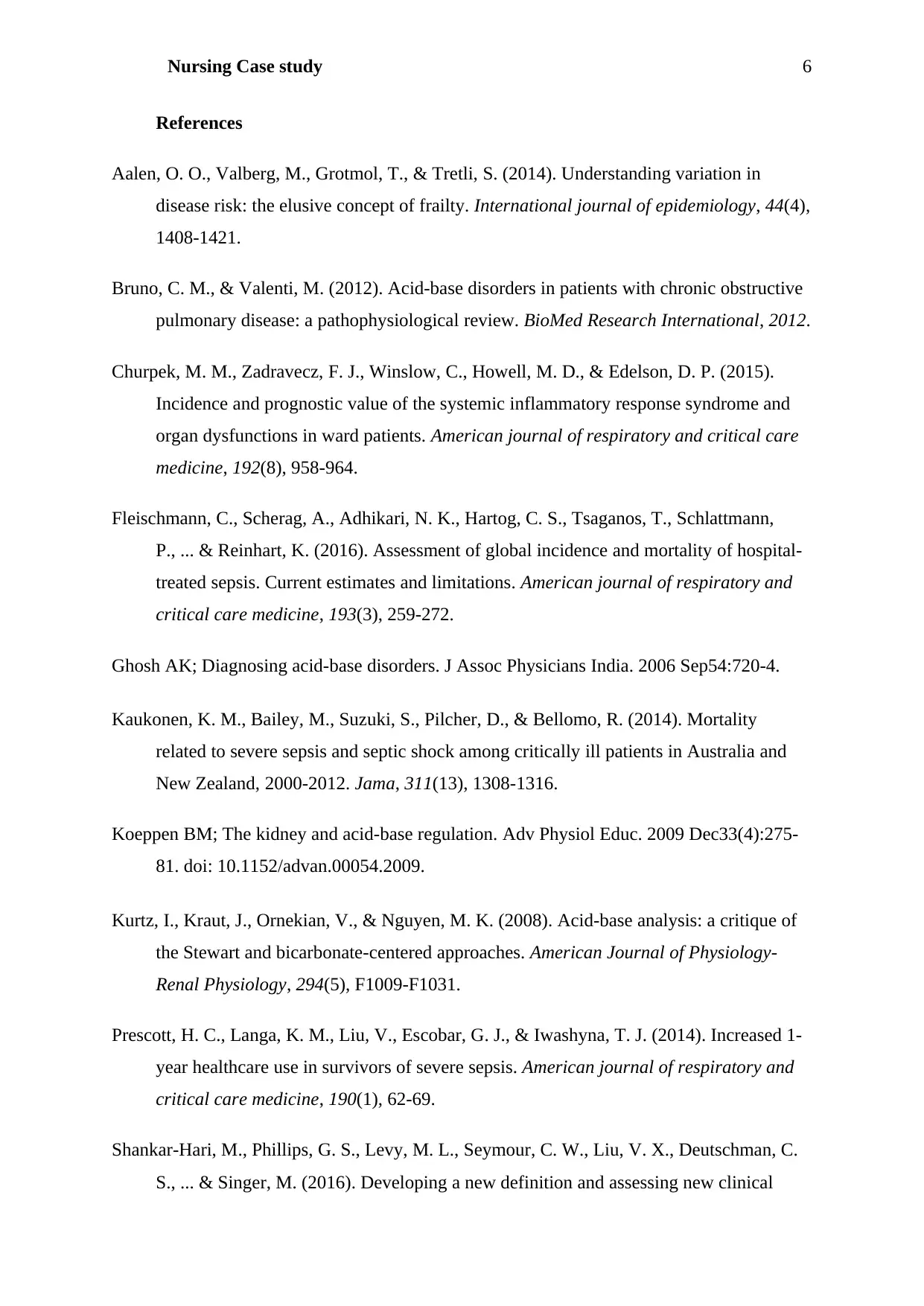
Nursing Case study 6
References
Aalen, O. O., Valberg, M., Grotmol, T., & Tretli, S. (2014). Understanding variation in
disease risk: the elusive concept of frailty. International journal of epidemiology, 44(4),
1408-1421.
Bruno, C. M., & Valenti, M. (2012). Acid-base disorders in patients with chronic obstructive
pulmonary disease: a pathophysiological review. BioMed Research International, 2012.
Churpek, M. M., Zadravecz, F. J., Winslow, C., Howell, M. D., & Edelson, D. P. (2015).
Incidence and prognostic value of the systemic inflammatory response syndrome and
organ dysfunctions in ward patients. American journal of respiratory and critical care
medicine, 192(8), 958-964.
Fleischmann, C., Scherag, A., Adhikari, N. K., Hartog, C. S., Tsaganos, T., Schlattmann,
P., ... & Reinhart, K. (2016). Assessment of global incidence and mortality of hospital-
treated sepsis. Current estimates and limitations. American journal of respiratory and
critical care medicine, 193(3), 259-272.
Ghosh AK; Diagnosing acid-base disorders. J Assoc Physicians India. 2006 Sep54:720-4.
Kaukonen, K. M., Bailey, M., Suzuki, S., Pilcher, D., & Bellomo, R. (2014). Mortality
related to severe sepsis and septic shock among critically ill patients in Australia and
New Zealand, 2000-2012. Jama, 311(13), 1308-1316.
Koeppen BM; The kidney and acid-base regulation. Adv Physiol Educ. 2009 Dec33(4):275-
81. doi: 10.1152/advan.00054.2009.
Kurtz, I., Kraut, J., Ornekian, V., & Nguyen, M. K. (2008). Acid-base analysis: a critique of
the Stewart and bicarbonate-centered approaches. American Journal of Physiology-
Renal Physiology, 294(5), F1009-F1031.
Prescott, H. C., Langa, K. M., Liu, V., Escobar, G. J., & Iwashyna, T. J. (2014). Increased 1-
year healthcare use in survivors of severe sepsis. American journal of respiratory and
critical care medicine, 190(1), 62-69.
Shankar-Hari, M., Phillips, G. S., Levy, M. L., Seymour, C. W., Liu, V. X., Deutschman, C.
S., ... & Singer, M. (2016). Developing a new definition and assessing new clinical
References
Aalen, O. O., Valberg, M., Grotmol, T., & Tretli, S. (2014). Understanding variation in
disease risk: the elusive concept of frailty. International journal of epidemiology, 44(4),
1408-1421.
Bruno, C. M., & Valenti, M. (2012). Acid-base disorders in patients with chronic obstructive
pulmonary disease: a pathophysiological review. BioMed Research International, 2012.
Churpek, M. M., Zadravecz, F. J., Winslow, C., Howell, M. D., & Edelson, D. P. (2015).
Incidence and prognostic value of the systemic inflammatory response syndrome and
organ dysfunctions in ward patients. American journal of respiratory and critical care
medicine, 192(8), 958-964.
Fleischmann, C., Scherag, A., Adhikari, N. K., Hartog, C. S., Tsaganos, T., Schlattmann,
P., ... & Reinhart, K. (2016). Assessment of global incidence and mortality of hospital-
treated sepsis. Current estimates and limitations. American journal of respiratory and
critical care medicine, 193(3), 259-272.
Ghosh AK; Diagnosing acid-base disorders. J Assoc Physicians India. 2006 Sep54:720-4.
Kaukonen, K. M., Bailey, M., Suzuki, S., Pilcher, D., & Bellomo, R. (2014). Mortality
related to severe sepsis and septic shock among critically ill patients in Australia and
New Zealand, 2000-2012. Jama, 311(13), 1308-1316.
Koeppen BM; The kidney and acid-base regulation. Adv Physiol Educ. 2009 Dec33(4):275-
81. doi: 10.1152/advan.00054.2009.
Kurtz, I., Kraut, J., Ornekian, V., & Nguyen, M. K. (2008). Acid-base analysis: a critique of
the Stewart and bicarbonate-centered approaches. American Journal of Physiology-
Renal Physiology, 294(5), F1009-F1031.
Prescott, H. C., Langa, K. M., Liu, V., Escobar, G. J., & Iwashyna, T. J. (2014). Increased 1-
year healthcare use in survivors of severe sepsis. American journal of respiratory and
critical care medicine, 190(1), 62-69.
Shankar-Hari, M., Phillips, G. S., Levy, M. L., Seymour, C. W., Liu, V. X., Deutschman, C.
S., ... & Singer, M. (2016). Developing a new definition and assessing new clinical
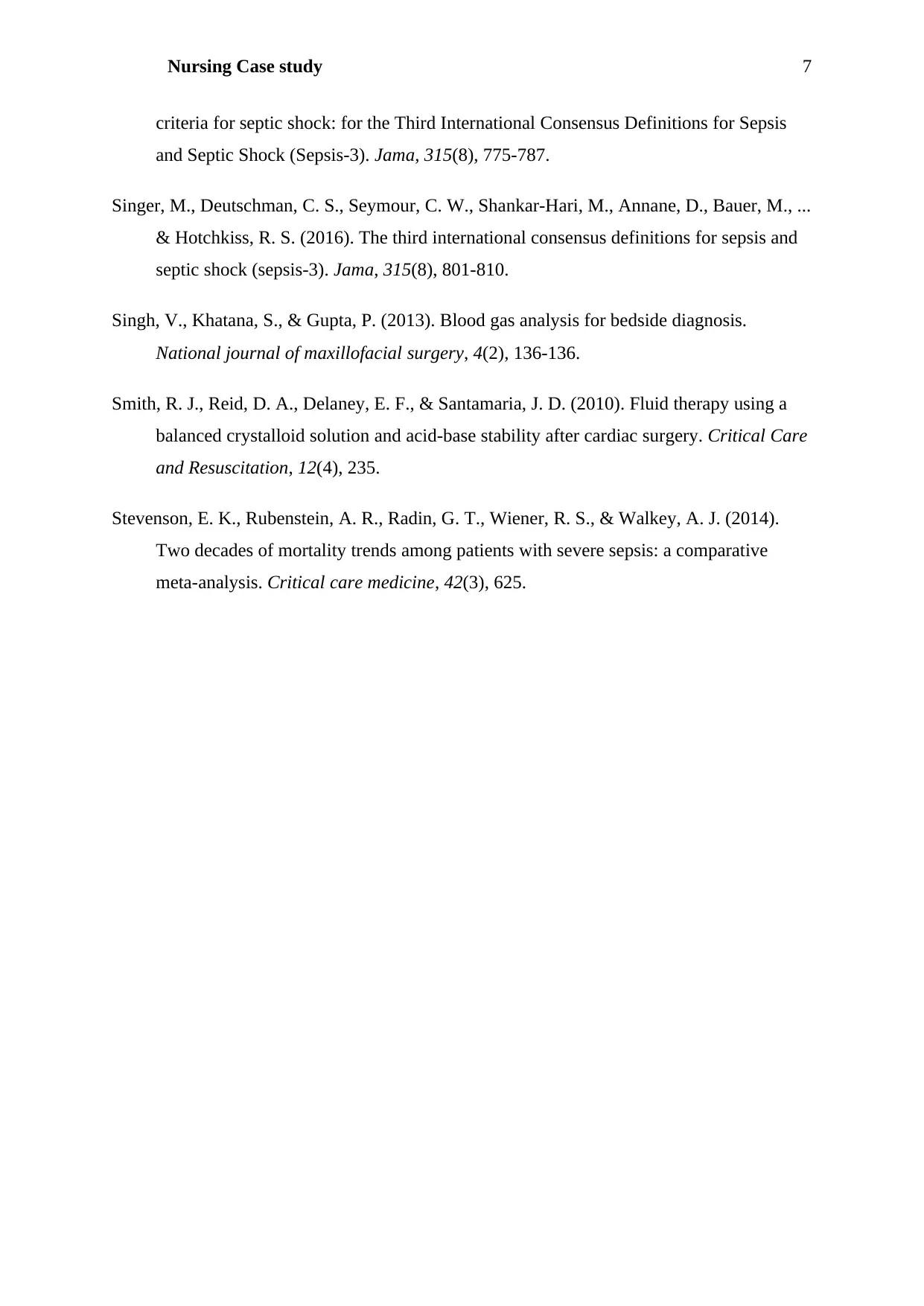
Nursing Case study 7
criteria for septic shock: for the Third International Consensus Definitions for Sepsis
and Septic Shock (Sepsis-3). Jama, 315(8), 775-787.
Singer, M., Deutschman, C. S., Seymour, C. W., Shankar-Hari, M., Annane, D., Bauer, M., ...
& Hotchkiss, R. S. (2016). The third international consensus definitions for sepsis and
septic shock (sepsis-3). Jama, 315(8), 801-810.
Singh, V., Khatana, S., & Gupta, P. (2013). Blood gas analysis for bedside diagnosis.
National journal of maxillofacial surgery, 4(2), 136-136.
Smith, R. J., Reid, D. A., Delaney, E. F., & Santamaria, J. D. (2010). Fluid therapy using a
balanced crystalloid solution and acid-base stability after cardiac surgery. Critical Care
and Resuscitation, 12(4), 235.
Stevenson, E. K., Rubenstein, A. R., Radin, G. T., Wiener, R. S., & Walkey, A. J. (2014).
Two decades of mortality trends among patients with severe sepsis: a comparative
meta-analysis. Critical care medicine, 42(3), 625.
criteria for septic shock: for the Third International Consensus Definitions for Sepsis
and Septic Shock (Sepsis-3). Jama, 315(8), 775-787.
Singer, M., Deutschman, C. S., Seymour, C. W., Shankar-Hari, M., Annane, D., Bauer, M., ...
& Hotchkiss, R. S. (2016). The third international consensus definitions for sepsis and
septic shock (sepsis-3). Jama, 315(8), 801-810.
Singh, V., Khatana, S., & Gupta, P. (2013). Blood gas analysis for bedside diagnosis.
National journal of maxillofacial surgery, 4(2), 136-136.
Smith, R. J., Reid, D. A., Delaney, E. F., & Santamaria, J. D. (2010). Fluid therapy using a
balanced crystalloid solution and acid-base stability after cardiac surgery. Critical Care
and Resuscitation, 12(4), 235.
Stevenson, E. K., Rubenstein, A. R., Radin, G. T., Wiener, R. S., & Walkey, A. J. (2014).
Two decades of mortality trends among patients with severe sepsis: a comparative
meta-analysis. Critical care medicine, 42(3), 625.
1 out of 7
Related Documents
Your All-in-One AI-Powered Toolkit for Academic Success.
+13062052269
info@desklib.com
Available 24*7 on WhatsApp / Email
![[object Object]](/_next/static/media/star-bottom.7253800d.svg)
Unlock your academic potential
© 2024 | Zucol Services PVT LTD | All rights reserved.





